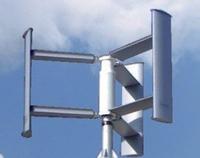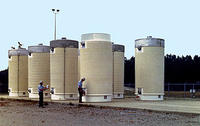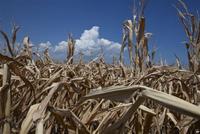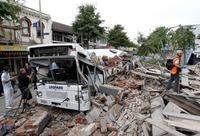-
A second look at off-shore use of vertical-axis wind turbines

Wind energy researchers are re-evaluating vertical axis wind turbines (VAWTs) to help solve some of the problems of generating energy from offshore breezes; though VAWTs have been around since the earliest days of wind energy research, VAWT architecture could transform offshore wind technology
-
-
Raytheon's Space Fence technology tracks space debris

Space debris threatens systems the U.S. military and economy depend on every day, including satellites that power navigation, weather and critical infrastructures; the Space Fence program is capable of detecting more and much smaller objects in low earth orbit
-
-
Surface coal mining destroying West Virginia streams, rivers
More than 22 percent of streams and rivers in southern West Virginia have been degraded to the point they may now qualify as impaired under state criteria; the substantial losses in aquatic insect biodiversity and increases in salinity is linked to sulfates and other pollutants in runoff from mines often located miles upstream
-
-
Science group: storing spent nuclear fuel in dry casks significantly safer then wet pools storage

An NRC report on the lessons of the Fukushima disaster says that storing spent nuclear fuel in wet pools is “adequate” to protect the public; a science groups says there is a significantly safer way to store the 55,000 tons of radioactive waste currently stored by the 104 nuclear power plants operating in the United States: transferring the spent fuel to dry casks
-
-
Chronic 2000-4 U.S. drought, worst in 800 years, may be the "new normal"

The chronic drought that hit western North America from 2000 to 2004 left dying forests and depleted river basins in its wake and was the strongest in 800 years, scientists have concluded, but they say those conditions will become the “new normal” for most of the coming century
-
-
Food prices in U.S., world set to rise as a result of drought
The U.S. Midwest is suffering the worst drought since 1956, and a total of 1,369 counties in thirty-one states across the United States have been designated for disaster aid; the prolonged drought will lead to an increase in food prices in 2013 as animal feed costs increase
-
-
Global warming unequivocal in its advance, says NCAA expert
Global warming is unequivocal in its advance and will lead to more record-setting temperatures, says Warren Washington, a senior scientist at the National Center for Atmospheric Research; in a talk at Sandia Lab, Washington presented graph after graph showing how various atmospheric processes have combined to create stronger rainfall near the equator and more intense droughts in the subtropics, as well as sea-level rises and increased storm surges
-
-
Predictions by climate models are flawed, says MIT meteorology expert
Massachusetts Institute of Technology professor Richard Lindzen, a global warming skeptic, says that too much is being made of climate change by researchers seeking government funding; he said their data and their methods did not support their claims; for thirty years, climate scientists have been “locked into a simple-minded identification of climate with greenhouse-gas level. That climate should be the function of a single parameter (like CO2) has always seemed implausible. Yet an obsessive focus on such an obvious oversimplification has likely set back progress by decades,” Lindzen said
-
-
Large, magnitude 8 earthquakes hit New Zealand with regularity

A new study finds that very large earthquakes have been occurring relatively regularly on the Alpine Fault along the southwest coastline of New Zealand for at least 8,000 years
-
-
Studying the physics of avalanches

Snow avalanches, a real threat in countries from Switzerland to Afghanistan, are fundamentally a physics problem: What are the physical laws that govern how they start, grow, and move, and can theoretical modeling help predict them? New study offers answers
-
-
Capturing CO2 directly from air is chemically, economically viable
With a series of papers published in chemistry and chemical engineering journals, researchers from the Georgia Institute of Technology have advanced the case for extracting carbon dioxide directly from the air using newly developed adsorbent materials
-
-
Pulling CO2 from air feasible, if still costly, way to curb global warming
Emerging techniques to pull carbon dioxide from the air and store it away to stabilize the climate may become increasingly important as the planet tips into a state of potentially dangerous warming; lower-cost technology is a stumbling block so far
-
-
Temperature rise, CO2 follow each other closely
The greatest climate change the world has seen in the last 100,000 years was the transition from the ice age to the warm interglacial period; new research indicates that, contrary to previous opinion, the rise in temperature and the rise in the atmospheric CO2 follow each other closely in terms of time
-
-
Replacing coal with natural gas would reduce global warming
A new study finds that a gas substitution scenario, in which natural gas replaces all coal power production and any new oil-powered facilities by midcentury, would realize 40 percent of the reduction in global warming that could be achieved with a full switch to low-carbon fuel sources; this is a less costly, and more feasible, option, than switching all electricity generation immediately and aggressively to non-fossil fuel sources such as solar, wind, and nuclear
-
-
Per capita CO2 emissions in China reach EU levels
Global emissions of carbon dioxide (CO2) increased by 3 percent last year; an estimated cumulative global total of 420 billion tons of CO2 has been emitted between 2000 and 2011 due to human activities, including deforestation; scientists suggest that in order to limit the rise in average global temperature to 2°C above pre-industrial levels, cumulative CO2 emissions in the period 2000–50 cannot do not exceed 1,000 to 1,500 billion tons
-
More headlines
The long view
How Climate Change Will Affect Conflict and U.S. Military Operations
“People talk about climate change as a threat multiplier,” said Karen Sudkamp, an associate director of the Infrastructure, Immigration, and Security Operations Program within the RAND Homeland Security Research Division. “But at what point do we need to start talking about the threat multiplier actually becoming a significant threat all its own?”
